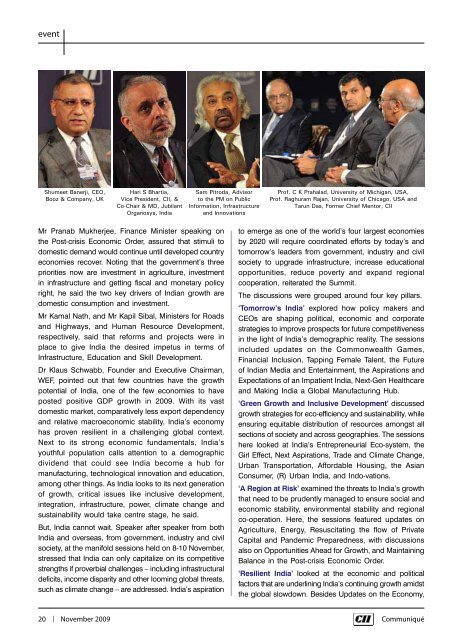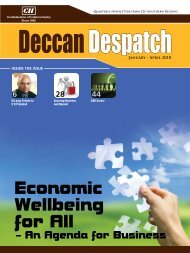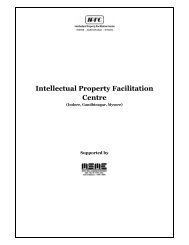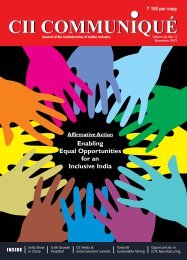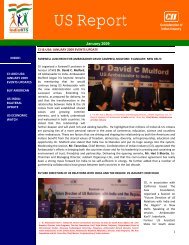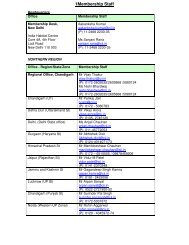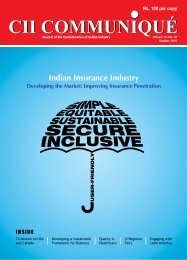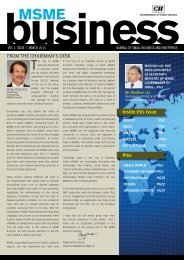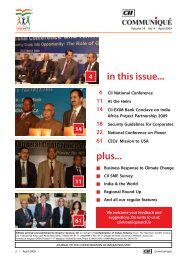Communiqué November 2009 | 1 - CII
Communiqué November 2009 | 1 - CII
Communiqué November 2009 | 1 - CII
- No tags were found...
You also want an ePaper? Increase the reach of your titles
YUMPU automatically turns print PDFs into web optimized ePapers that Google loves.
eventShumeet Banerji, CEO,Booz & Company, UKHari S Bhartia,Vice President, <strong>CII</strong>, &Co-Chair & MD, JubilantOrganosys, IndiaSam Pitroda, Advisorto the PM on PublicInformation, Infrastructureand InnovationsProf. C K Prahalad, University of Michigan, USA,Prof. Raghuram Rajan, University of Chicago, USA andTarun Das, Former Chief Mentor, <strong>CII</strong>Mr Pranab Mukherjee, Finance Minister speaking onthe Post-crisis Economic Order, assured that stimuli todomestic demand would continue until developed countryeconomies recover. Noting that the government’s threepriorities now are investment in agriculture, investmentin infrastructure and getting fiscal and monetary policyright, he said the two key drivers of Indian growth aredomestic consumption and investment.Mr Kamal Nath, and Mr Kapil Sibal, Ministers for Roadsand Highways, and Human Resource Development,respectively, said that reforms and projects were inplace to give India the desired impetus in terms ofInfrastructure, Education and Skill Development.Dr Klaus Schwabb, Founder and Executive Chairman,WEF, pointed out that few countries have the growthpotential of India, one of the few economies to haveposted positive GDP growth in <strong>2009</strong>. With its vastdomestic market, comparatively less export dependencyand relative macroeconomic stability, India’s economyhas proven resilient in a challenging global context.Next to its strong economic fundamentals, India’syouthful population calls attention to a demographicdividend that could see India become a hub formanufacturing, technological innovation and education,among other things. As India looks to its next generationof growth, critical issues like inclusive development,integration, infrastructure, power, climate change andsustainability would take centre stage, he said.But, India cannot wait. Speaker after speaker from bothIndia and overseas, from government, industry and civilsociety, at the manifold sessions held on 8-10 <strong>November</strong>,stressed that India can only capitalize on its competitivestrengths if proverbial challenges – including infrastructuraldeficits, income disparity and other looming global threats,such as climate change – are addressed. India’s aspirationto emerge as one of the world’s four largest economiesby 2020 will require coordinated efforts by today’s andtomorrow’s leaders from government, industry and civilsociety to upgrade infrastructure, increase educationalopportunities, reduce poverty and expand regionalcooperation, reiterated the Summit.The discussions were grouped around four key pillars.‘Tomorrow’s India’ explored how policy makers andCEOs are shaping political, economic and corporatestrategies to improve prospects for future competitivenessin the light of India’s demographic reality. The sessionsincluded updates on the Commonwealth Games,Financial Inclusion, Tapping Female Talent, the Futureof Indian Media and Entertainment, the Aspirations andExpectations of an Impatient India, Next-Gen Healthcareand Making India a Global Manufacturing Hub.‘Green Growth and Inclusive Development’ discussedgrowth strategies for eco-efficiency and sustainability, whileensuring equitable distribution of resources amongst allsections of society and across geographies. The sessionshere looked at India’s Entrepreneurial Eco-system, theGirl Effect, Next Aspirations, Trade and Climate Change,Urban Transportation, Affordable Housing, the AsianConsumer, (R) Urban India, and Indo-vations.‘A Region at Risk’ examined the threats to India’s growththat need to be prudently managed to ensure social andeconomic stability, environmental stability and regionalco-operation. Here, the sessions featured updates onAgriculture, Energy, Resuscitating the flow of PrivateCapital and Pandemic Preparedness, with discussionsalso on Opportunities Ahead for Growth, and MaintainingBalance in the Post-crisis Economic Order.‘Resilient India’ looked at the economic and politicalfactors that are underlining India’s continuing growth amidstthe global slowdown. Besides Updates on the Economy,20 | <strong>November</strong> <strong>2009</strong> Communiqué


